If you’re looking for information about dental crown costs, types, and procedures, you’re in the right place. Maybe you need a tooth crown to restore a damaged tooth. Or perhaps you want to get a smile makeover without invasive implant surgery.
Whatever the reason, you’re bound to have some questions about getting caps on your teeth.
In this comprehensive guide, we’ll cover the pros and cons of different types of crown. You’ll find out what to expect when you visit the dentist for the procedure, and how much dental crowns cost in the US.
We’ll also explain how to care for your crowns to make them last as long as possible (which could be 20 years or more).
In This Article
What is a dental crown?
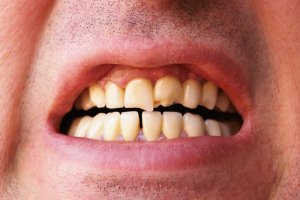
A crown is a tooth-shaped covering that completely encases the visible part of the tooth.
There are a number of reasons why someone may have a crown fitted:
- To restore a broken, damaged or chipped tooth
- To add strength to a weakened tooth
- Where a tooth has decayed and too much is missing for a filling
- To improve the cosmetic appearance of teeth
- To restore a tooth that previously had a very large filling that may be breaking down
- To reinforce and seal a tooth following a root canal
Crowns can be made from a variety of different materials. Some are metal-colored while some are designed to look like natural teeth. We’ll cover these in more detail later on.
Before dental technology evolved to allow for the dental crown procedure, the only way to deal with a damaged or heavily decayed tooth was to remove it. Thanks to teeth crowns, dentists now have a way to save much of the tooth structure and avoid the discomfort of a tooth extraction, and a lifetime of living with a removable prosthesis, like a denture or partial denture.
Unlike a dental filling, which repairs just a portion of the tooth, a crown restores the whole tooth. Capped teeth should function and feel just like a natural tooth.
What’s the difference between a tooth crown and a tooth cap?
You might have heard the terms ‘crown’ and ‘cap’ used and are wondering what the difference is. Well, it turns out, crown and cap are both names for the same thing.
‘Dental cap’ is a less technical term for ‘dental crown’, but they both refer to a whole tooth covering placed on top of a shaved-dsown tooth. Some people might say that a ‘crown’ is metal-colored while a ‘cap’ is tooth-colored, but this is not a differentiation that dentists make.
We’ll use both terms interchangeably in this article, but now you know that they both refer to the same thing.
Another term that may refer to a dental crown is “onlay.” An onlay is a similar restoration that can be created in a manner that is even more conservative in saving healthy tooth structure. With the advent of dental bonding technologies, we can be more conservative than ever when preparing a tooth for a crown.
Types of dental crowns
The most common materials for teeth caps are:
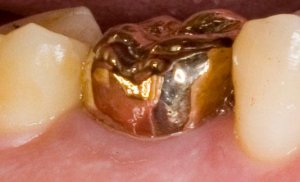
- Ceramic: This can include porcelain or zirconia, colored to match the surrounding teeth
- Metal alloys: Including gold, platinum, palladium, and non-precious metals; either “white” (silver-colored) or “yellow” (gold-colored). Some people may get gold crowns because they like the aesthetics of gold teeth (read more about other gold dental swag here).
- Porcelain-fused-to-metal (PFM): A combination of the above, with ceramic fused to an inner metal crown
- Resin/composite: Cheaper than other types and don’t last as long—may be used for temporary crowns while you wait for a permanent crown
Best dental crown material
Each of the materials has its own set of advantages and disadvantages, so the right crown material for you will depend on which teeth are being capped, how you want them to look esthetically, and how long you need them to last.
Ceramic crowns are crafted in a lab and built up layer by layer, sometimes with the help of CAD/CAM dental technology. This gives them the same slightly translucent appearance of natural teeth and makes them a popular choice for front teeth that will be on show. They can also be created chairside using a new technology for milling crowns while you wait. These are great because they can be completed in only one visit with no need for a provisional cap.
The downside of any ceramic material is that, although it is very strong, it is more brittle than metal and liable to crack or chip over time, but when fabricated correctly, they should be expected to last 15+ years. Some ceramic crowns, like Emax caps, are designed differently to be more durable.
Gold dental crowns and those made from other alloy metals tend to be much more durable. They have the added benefit of being biocompatible with teeth, which means the capped teeth shouldn’t cause any damage or wear to the teeth they bite against. A gold crown can last a lifetime if the patient does their homework of keeping it clean and healthy.
The obvious drawback of any metal crown is the color. Many people simply don’t want a gold- or silver-colored tooth on show, even if it is tucked away at the back.
For others, having a gold tooth crown is quite appealing and they may go as far as to have it engraved or studded with gemstones!
PFM crowns offer some of the strength of metal with the esthetics of porcelain crowns. However, they don’t usually look quite like natural teeth because of the way they are layered. It’s still possible for the ceramic coating to chip or crack, but the metal underneath will remain intact. However, they will almost always fil at the point where the two materials are joined. If the gums recede over time, a dark gray metal line can be seen and may be considered quite unappealing.
How much does a crown cost without insurance?
Silver tooth caps cost from $500 to $1,500 while all-ceramic crowns cost up to $2,000 each. While crowns are quite expensive, they are an essential part of many restorative dental procedures. They shouldn’t be discarded just because of the price tag.
As with any dental treatment, tooth cap prices vary greatly from one place to another and from one dental clinic to the next. It’s worth shopping around and comparing prices between dentists near you, especially if you need to get more than one of your teeth crowned.
There is also more to consider than just the cost of a tooth cap; as discussed above, there are pros and cons to each type of crown. In addition to asking your dentist about dental crown costs, inquire about the different options that may be suitable for you. A good practice is to ask your doctor what they would choose to have in their own mouth if they found themselves in a similar situation.
As you can see from the table below, full metal crowns are generally the least expensive, and full ceramic the most expensive. Front tooth crowns can be more costly as more time needs to be put into giving them a natural look.
Type of crown | Cost | Strenth/durability | Aesthetics | Other commments |
Metal | $500 - $1,500 | $800 - $2,000 | $600 - $1,800 | $700 - $2,000 |
Ceramic (porcelain) | Excellent; very long-lasting | The least durable material; liable to crack or chip | Although the metal inside is strong, the outer porcelain can chip | Can chip just like porcelain |
Porcelain-fused-to-metal | Gold or silver-colored so easily noticeable | Created to look just like natural teeth | Tooth-colored but doesn't always have the translucency of natural teeth | The fast production process makes it harder to achieve a natural look |
One-day CEREC crown | Won't wear down other teeth | Can gradually wear away other teeth it bites against | May gradually wear away other teeth it bites against | Can gradually wear away other teeth it bites against |
If you need more than one, your dentist may offer a slightly lower price per crown. However, the material costs and fitting time per crown stay pretty much fixed regardless of how many you have.
How much does a crown cost with insurance?
This will depend on your plan but insurance can cover anywhere from $100 to $1,000. You should also keep in mind your policy deductible and limits when you are figuring the cost for your crowns. For more information, read about the best dental insurance that covers crowns with no waiting period.
We know that dental insurance can be expensive and it can also be difficult to know which plan to choose.
But we are here for you — we’ve created a special comparison tool that shows you the top plans in your area to help guide you in your decision.
It takes just a few seconds to fill in your DOB and zip code, and you’ll see full coverage plans that cover your needs. Get started with the form below!

Reducing the tooth crown cost
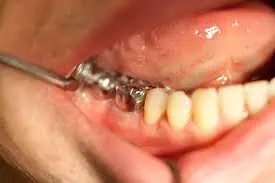
While private dental insurance may cover some or all of the costs you incur at various stages of the process, this treatment is often only covered after a waiting period – typically between three months and one year after your policy starts.
If you’re electing to get caps for your teeth for cosmetic reasons, check whether this is included in your policy.
Read more about dental plans in the US, including what is and isn’t covered by certain providers. Keep in mind that you may have to pay for root canal treatment in addition to your crown.
For purely cosmetic improvements, dental veneers may also be an option. Speak to your dentist to find out which is the best choice for you.
Getting cheap dental crowns abroad
Depending on the number of crowns you need, it may be more cost-effective to travel abroad for the treatment, however, you may also have no recourse should things go awry.
Dental tourism is becoming ever more popular as Americans find themselves unable to afford complex dental care at home. However, some dentists recommend visiting a US dental school as a better alternative. You can get excellent care under the supervision of an instructor for about one half of the cost of private practice.
If traveling from the US, you can get a PFM crown for $250 to $600 in places like Mexico and Costa Rica. If you need other dental work too, you stand to save even more. Some towns on the Mexican border have hundreds of dental clinics catering specifically to international patients who visit for a day or more to get their teeth done.
Dental crown procedure
Visit 1: preparation
The dental crown procedure involves removing about one to two millimeters of tooth structure to ensure a proper fit and long-lasting function.
But before this, your dentist may take an x-ray to make sure your tooth is healthy enough to invest in and to check for any underlying complications. If all is well, the dentist will numb your tooth and surrounding gums with an anesthetic, a type of dental sedation.
A root canal treatment may be necessary prior to your crown if you have pain, a severe crack or decay in the nerve. It’s also possible that your dentist will surgically remove some of the gum tissue to create a better base for the cap.
Your dentist will also remove all traces of decay, as well as any material from previous fillings. If this leaves very little tooth left to work with, he or she may build it back up again with a filling material. Once this is done, the tooth preparation must include slight tapering to be thinner on the top, so the tooth cap can easily slip over it.
Next, the dentist takes an impression or digital scan of what’s left of the tooth so the crown can be created to fit it perfectly. It can take 2-3 weeks for the crown to be made in the specialist lab, so the dentist fits a temporary cap (made from composite or acrylic) to stop any sensitivity in the tooth and keep it functional and looking nice in the interim.
The color of the temporary teeth cap should blend in with your natural teeth, but the material and finish aren’t as high-quality as the permanent cap will eventually be. It’s at this point that your dentist will also choose the shade for your crown if you’re getting it made in a material to match your teeth.
This first visit usually takes between 45 minutes and one hour.
Visit 2: fitting
Once the permanent crown arrives, you’ll visit your dentist again to have it fitted. The provisional tooth cap will be removed, and your dentist may again numb the tooth to avoid any sensitivity during this time.
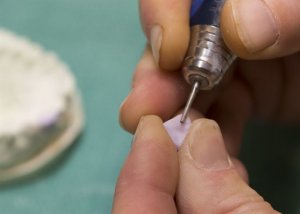
After checking that the fit of the new crown is just right, your dentist will apply a dental cement or resin bonding material on the inside of the crown and press it down over your tooth. Any excess that has seeped out will be scraped away, and the process is complete.
If you have any concerns about the color or shape of the permanent crown (especially for a front tooth crown), be sure to speak up before it’s cemented. Also, be sure your dentist allows you to look at it prior to the finanl cementation. Consider going outside to look at it in natural light, which can be the most honest. It’s difficult to make any changes once your new cap is in place, and you’ll have to live with it for a long time!
The duration of this second visit depends on how many adjustments are needed before the crown can be cemented, but on average it takes 30 minutes – one hour.
Your capped teeth may feel a bit strange at first since they won’t be exactly the same as your original ones. As long as they aren’t interfering with your bite you should get used to them within a couple of weeks.
The following video shows the full process of removing an old crown and fitting a new one. Be aware, it contains some close-ups of needles and drilling.
One-day CEREC crown fitting
There is an option on the market which lets you avoid multiple visits and weeks or months with a provisional crown.
CEREC technology allows dentists to make crowns on-site in just an hour or so from digital scans taken of your mouth. There’s no doubt that this is a more convenient option for patients, and many are happy to forego the unpleasant dental impression process.
CEREC crowns are relatively new to the market, meaning that not much data is available on their long-term performance. However, the general consensus from dentists is that while they are a strong and esthetically pleasing option for back teeth, they can’t match the natural look of hand-crafted porcelain crowns for the very front teeth.
These dental crowns cost about the same as regular crowns because although there is no lab work involved and the process is faster, your dentist has to pay a lot for the machine that makes them.
Recovery and care of dental crowns
How long do capped teeth last?
Although crowns are a long-term solution to restore damaged teeth, they don’t last forever. Some materials are more durable than others; gold, for example, won’t chip or crack like porcelain does.
Your dentist may tell you to expect your crown to last five to 15 years, but many last a great deal longer than this. A 2013 study assessed 2,340 gold-based PFM crowns and found that 97% lasted longer than 10 years while 85% were still going strong at the 25-year mark.
Another more recent study found that
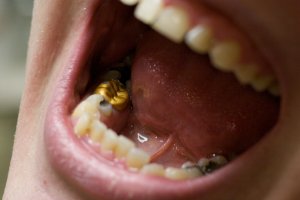
Your crown will eventually need to be replaced if:
- It becomes cracked or broken (ceramic)
- It wears down (metal) or is causing excessive wear to other teeth (ceramic)
- The tooth inside experiences decay
- Its cosmetic appearance deteriorates (in the case of a front tooth crown)
Gold tooth crowns are generally the strongest but may wear down in places if the patient suffers from bruxism (tooth grinding). This condition can also be a problem for patients with porcelain crowns as this material is more likely to wear away other teeth that bite against it. If you do grind your teeth at night, it may be smart to invest in a custom-made nightguard to keep your natural teeth and crowns protected. It’s much cheaper than needing to crown multiple teeth due to wear!
Crowns are used to restore and enhance teeth that are damaged, or to take the place of missing teeth. A crown, also referred to as a cap, is used to entirely cover a damaged tooth. A crown not only strengthens a tooth, but it can drastically improve a tooth’s appearance, shape and alignment.
Temporary crowns are a good option to help with a patient’s current problem before a permanent crown can be made and secured into place. It’s important to note that temporary crowns are more sensitive to breaking, so being extra careful when brushing, flossing, and eating is important.
Dr. Ashley Niles, Niles Family Dentistry
Caring for a temporary cap
While your temporary tooth cap is in place you should avoid any chewy or sticky foods (like chewing gum or soft candies) that may pull it off. Hard foods, like raw carrots and apples, are also best avoided. Try to bite and chew mainly on the side of your mouth away from the crown, or only use the crowned tooth to bite very soft foods. You can read our temporary crown article for more information on care.
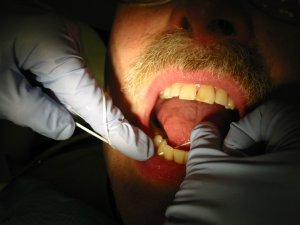
Caring for permanent dental caps
Your dentist may well advise you to avoid hard or chewy foods for the first day after your crown is fitted. This gives the cement enough time to set properly. Once you have regained normal feeling in your mouth, carefully test the bite of your crown in all directions.
If anything feels odd, report straight back to your dentist. He or she can refine the shape and ensure your crown isn’t interfering with your other teeth. A spot that feels high will not go away on its own and can eventually cause pain in the tooth and jaw.
In the longer term, teeth with crowns should be cared for in just the same way as regular teeth by brushing twice a day and flossing daily. If you’re worried about dental floss catching on the edge of your crown, consider investing in a water flosser instead, (read about some of the best water flosser options). You should be able to eat whatever you want, but never use your teeth or your crowns as a tool—no biting open a plastic bag. Get some scissors!
If your gums start to recede, this can cause sensitive teeth in parts of the tooth not covered by the cap. It’s therefore important to minimize the risk of gum disease by having your teeth regularly cleaned by a hygienist.
In the case of PFM caps, if the gum recedes to below where the ceramic coating was applied, the metal will start to appear, resulting in a visible line right at the gum line.
If your crown chips or comes off completely, contact your dentist immediately so they can assess the damage. Chips can be temporarily filled with composite resin or tooth repair kits but the only permanent solution is to replace the entire crown. It’s possible to re-cement a crown that has come off providing there is no damage to it.
Dental crown problems
When you get a dental crown you may experience the following problems:
- Sensitivity: Newly crowned teeth can experience sensitivity after the crowning procedure. However, if you continue to experience tooth crown pain, especially when you bite down, you should call your dentist so they can fix it.
- Loose crown: The cement that fixes your crown to the tooth may wash out, causing your crown to feel loose. This exposes the tooth and gums underneath to harmful bacteria so it’s important to see your dentist if you think your crown is loose.
- Crown tooth hurts years later: What if you experience pain years after you get a crown? This could be a sign of an infection or nerve trauma. It’s important to contact your dentist.
- Throbbing tooth pain after crown: This could be a sign of a loose crown, further damage to your tooth, or infection. You should contact your dentist.
- Crown falls out: If your crown falls out, you should contact your dentist to make an appointment, keep the crown safe, and don’t chew on the exposed tooth in the meantime.
- Chipped crown: Small chips in crowns can be repaired, whereas larger ones may require replacement. Either way, contact your dentist in the case of a chipped crown.
Conclusion
Dental crowns or caps are used to protect damaged teeth. Teeth can be damaged from decay, injuries or wear and tear over the years. Crowns are shaped like teeth and can be placed over your tooth. They have a snug fit and are cemented for permanent wear. They are usually either made of metal, porcelain or resin.
Porcelain crowns have the most natural look, but they can wear faster than metal crowns. Many people choose to get porcelain or ceramic teeth in the front, and stronger metal crowns for back molars.
Sometimes, a crown can become loose or fall off. If this is the case, it’s important to see your dentist to get it fixed as soon as possible. If you need help finding a dentist, you can call 866-383-0748. Alternatively, you may want to schedule an appointment with a dentist online. To find out more about how this works, you can read our full guide to teledentistry and online dental appointments.
FAQs
What are dental crowns made of?
Dental crowns can be made of metal, including nickel, chromium and gold. They can also be made from porcelain, ceramic, resin, (cheaper and doesn’t last as long) and porcelain-fused-to-metal.
How long do dental crowns last?
A dental crown can last anywhere from 5 to 20 years. The lifetime of your crown will depend on how well you ocare for it, and the amount of wear and tear it deals with on a daily basis.
Why are dental crowns so expensive?
Technology and skill is required on the part of your dentist when placing a crown. Crowns are meticulously designed to perfectly match your teeth in strength and stability.
NCBI: The up to 25-year survival and clinical performance of 2,340 high gold-based metal-ceramic single crowns. Consulted April 1 2021.




